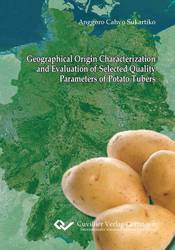| Departments | |
|---|---|
| Book Series (96) |
1378
|
| Nachhaltigkeit |
3
|
| Gesundheitswesen |
1
|
| Humanities |
2362
|
| Natural Sciences |
5406
|
| Mathematics | 229 |
| Informatics | 319 |
| Physics | 980 |
| Chemistry | 1363 |
| Geosciences | 131 |
| Human medicine | 243 |
| Stomatology | 10 |
| Veterinary medicine | 108 |
| Pharmacy | 147 |
| Biology | 835 |
| Biochemistry, molecular biology, gene technology | 121 |
| Biophysics | 25 |
| Domestic and nutritional science | 45 |
| Agricultural science | 1004 |
| Forest science | 201 |
| Horticultural science | 20 |
| Environmental research, ecology and landscape conservation | 148 |
| Engineering |
1790
|
| Common |
97
|
|
Leitlinien Unfallchirurgie
5. Auflage bestellen |
|
Advanced Search
Geographical Origin Characterization and Evaluation of Selected Quality Parameters of Potato Tubers (English shop)
Anggoro Cahyo Sukartiko (Author)Preview
Extract, PDF (240 KB)
Table of Contents, PDF (82 KB)
Consumers in Germany show an increasing interest in agricultural products that are associated with their region of origin. Therefore, on the side of producers, the increase in agricultural products registered as Geographical Indication (GI) products indicates a growing interest in this field. Considering the demand for GI products and an increasing number of agricultural products proposed as GI products, characterizing the geographical origin of the products is required to provide supplementary information to both the consumer and the producer, as well as protect them from fraud and the exploitation of the trust consumers have in their quality.
Potatoes, one of the GI commodities in Germany, are cultivated mostly in the northern, western and southern parts of the country. These three main potato-producing regions are characterized by different altitudes and are located in relatively different latitudinal coordinates. This leads to different environmental conditions, such as temperature and precipitation rates. These environmental conditions may influence the chemical composition and quality parameters of the potato tubers. Therefore, their geographical origin may be a relevant quality parameter. ACD, one of the important quality parameters, is influenced by the chemical composition of a tuber, of which organic acids and minerals are the most relevant to its determination.
Based on the background above, this study aims to characterize the geographical origin of potato tubers in Germany, particularly those from the northern, western and southern regions of the country; to evaluate the ACD of table potatoes cultivated in the three considered regions and to evaluate the contribution of selected tuber constituents to ACD.
The characterization of the geographical origin of the potato tubers was conducted with two discriminate parameters: stable isotope ratios and mineral compositions. Several cultivars were collected in 2010 and 2011 from the northern, western and southern regions. Their isotopic ratios and mineral compositions were analyzed.
Three stable isotope ratios, 18O, 2H and 13C, were chosen as the discriminate parameters. Tubers from the southern region were characterized with by 18O and 2H values, whereas tubers from the northern and western regions were characterized by higher 18O and 2H values. On the contrary, tubers from all studied regions had a relatively similar 13C values. Of the three, stable isotope 18O seemed to be the isotope with the highest discriminatory power, mainly for distinguishing potato samples obtained from the southern region from samples obtained from the other two regions. The other stable isotopes also contributed to the discrimination of potato samples from the northern, western and southern regions. However, tuber misclassification still occurred because of environmental effects.
In addition to stable isotope ratios, we also investigated the suitability of mineral compositions for characterizing the geographical origin of the tubers in Germany. No single mineral in either the non-periderm or periderm was able to characterize the geographical origin of the tubers. However, when examined with stepwise canonical discriminant analysis, composition of selected minerals was suitable for characterizing the geographical origin of the tubers, with a prediction ability of more than 85%.
As a whole, the results are in accord with, and contribute to, previous findings that suggest the suitability of stable isotope ratios for characterizing the geographical origin of agricultural products.
In general, potato tubers from these investigated regions had similar average levels of ACD, except for the tubers that were obtained from the northern region in 2011. However, organic acids, such as chlorogenic, citric and ascorbic acid, varied because of variations in environmental conditions and mineral fertilizations. We observed the contributions of citric and chlorogenic acid to the ACD, whereas other quality parameters, such as ascorbic acid and dry matter, did not correlate with ACD. Moderate to strong correlations were found between tubers’ ACD and some minerals; specifically, Mg, Mn and Fe. Variations in ACD among cultivars within the same region were observed. Cultivar ‘Soraya’ consistently had the lowest ACD susceptibility, while cultivars ‘Krone’ and ‘Red fantasy’ had the highest ACD susceptibility. As an implication, cultivar selection and an adequate water supply, therefore, should be taken into account when cultivating tubers in certain regions with different site-related factors and environmental conditions.
| ISBN-13 (Hard Copy) | 9783954043026 |
| ISBN-13 (eBook) | 9783736943025 |
| Final Book Format | A5 |
| Language | English |
| Page Number | 100 |
| Lamination of Cover | matt |
| Edition | 1. Aufl. |
| Publication Place | Göttingen |
| Place of Dissertation | Göttingen |
| Publication Date | 2012-12-05 |
| General Categorization | Dissertation |
| Departments |
Agricultural science
|
| Keywords | geographical origin, characterization, quality parameter, potato tuber |








